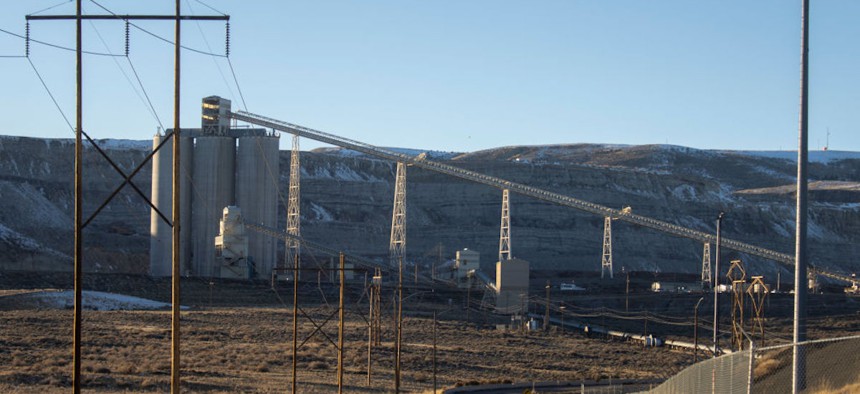New life for old coal: Mine lands and power plants are hot renewable development spots

Natalie Behring/Getty Images
Converting old coal plants to renewable energy storage sites can set states up for job creation and increased tax revenue, one observer says.
This story is republished from the Iowa Capital Dispatch. Read the original article.
PETERSBURG, Ind. — AES Indiana’s Petersburg Generating Station, which towers over the White River here in southwest Indiana, has been burning coal to generate electricity since the late 1960s.
That era, though, will come to an end soon. Two of the power plant’s four coal-burning units have already retired and the last is planned to shut down in 2025.
“AES Indiana will be the first utility out of coal in the state,” said Kelly Young, a spokeswoman for the company, which has more than half a million customers in the Indianapolis area.
Power generation, however, will continue. Two of those coal units will be switched out to cleaner-burning natural gas, and the company is also building an 800-megawatt-hour battery storage array at the Petersburg plant to take advantage of the existing grid connections and meet its electric capacity obligations. It will bank power when prices and power demand is low and discharge it when demand climbs and the regional grid operator, the Midcontinent Independent System Operator (MISO) needs the juice for the electric grid.
“The batteries are basically a time machine,” said Aaron Cooper, the company’s chief commercial officer for U.S. utilities. Cooper said the company opted for batteries after an exhaustive review of its obligations to its customers and the larger grid, (especially under MISO’s new winter rules that require more reserve margins) while also taking into account the costs and specifications of available generation technologies and new favorable tax rules for renewables as part of its long-range planning process.
AES’ project isn’t alone. Those same factors, along with the increasing resistance to new greenfield wind, solar and storage development, as well as massive backlogs in the queues to connect new power projects to the grid, mean former mine lands and the plants that burned the coal they produced are increasingly attractive spots for new renewable development.
Conversion of old coal plant sites to new storage and renewable projects is happening in New Jersey, Nevada, Louisiana and elsewhere across the country.
“Reuse of these interconnections is critical to driving down the cost of replacement generation,” said Justin Tomljanovic, a vice president of corporate development at Xcel Energy, which has 3.1 million electric customers in eight states and is building two battery arrays near retiring coal plants in Becker, Minnesota, and Pueblo, Colorado.
“We’re thinking about this at every single place where we’re retiring a coal plant. … It is a company strategy that we think enables us to hit our carbon goals and our states’ carbon goals cost effectively.”
Once and Future ‘Energy Communities’
States can play a major role in speeding these transitions, said Harry Godfrey, a managing director at Advanced Energy United, a trade association representing wind, solar, energy efficiency, battery storage and other businesses. On the one hand, renewable energy and decarbonization mandates are helping spur the transition to cleaner electricity. Twenty-three states have 100% clean energy goals.
Other policies, such as “securitization” legislation, can blunt the costs to consumers of retiring coal plants before the end of their useful lives. “They’re finding interesting financing options to manage those stranded costs,” Godfrey said.
Illinois has a grant program specifically designed to incentivize retiring or shuttered coal plants to install energy storage.
Also, tax credits in the landmark Inflation Reduction Act, the biggest piece of climate legislation in U.S. history, include a bonus 10% credit for “energy communities,” defined as brownfield sites, areas with large historic levels of employment or tax revenue derived from coal, oil, gas extraction or communities where a coal power station closed after 2009 or a coal mine closed after 1999, among other criteria.
“The Inflation Reduction Act is designed not just to lower energy costs and combat climate change, but to promote broad-based economic opportunity and create jobs in communities that have been at the forefront of energy production, especially coal communities,” said Deputy Secretary of the Treasury Wally Adeyemo in a statement in June. “Treasury is focused on ensuring all Americans benefit from the growth of the clean energy economy, particularly those who live in communities that have depended on the energy sector for jobs.”
(The Department of Energy keeps a map of eligible energy communities here.)
States that want to help speed the transition from old fossil fuel sites to new renewable energy facilities and take advantage of the jobs and tax revenue they can bring need to get on the ball, Godfrey said.
That means inventorying and packaging sites in a similar fashion as states do to lure developers for other big economic development projects like trying to attract a factory or distribution center, he said.
“The IRA is intentionally designed to promote these conversions,” he said. “The state’s role in economic development is really pivotal.”
Mine Lands and Brownfields
Danny Van Clief, CEO of Sun Tribe Development, part of Sun Tribe Solar, a Charlottesville, Virginia, company that’s one of the largest clean energy companies in the mid-Atlantic, said it’s become increasingly difficult to get large solar farms approved. “Some of that resistance is rational and some of that resistance is somewhat irrational. We’re actually battling organized resistance to the deployment of renewables,” he said.
That opposition, Van Clief said, “causes us to be incredibly thoughtful about where we site potential projects.” Former mine lands and other “previously disturbed areas” tend to be less controversial sites and inject investment into communities that mined the coal that powered the United States for most of its industrialized history but have fallen on hard times since.
Sun Tribe, along with another solar developer, Washington, D.C.-based Sol Systems, is working with The Nature Conservancy to build solar projects on former coal mine lands in Southwest Virginia, Eastern Tennessee and Eastern Kentucky, that fall within its Cumberland Forest Project, one of the group’s largest conservation efforts at 253,000 acres.
In Virginia, the state Energy Department, formerly the Department of Mines, Minerals and Energy, helped The Nature Conservancy identify non-forested former mine lands near existing utility lines and other infrastructure, which were then whittled down to avoid areas with important wildlife, habitat or other considerations that made them unsuitable for solar development.
The Nature Conservancy, which holds conservation easements on about 3.1 million acres in 49 states and is one of the largest landowners in the nation, is looking to take that approach across the country.
Nels Johnson, senior adviser for renewable energy at the conservancy’s Climate Mitigation Program, said some of the land the organization controls doesn’t have “direct conservation value.” They may be buffer areas, or part of a larger property that was purchased for conservation or agricultural leases next to a natural area, and may be suitable for renewable development.
A forthcoming report, Mining the Sun, will lay out a case for “strategically siting new energy infrastructure on degraded lands like mining sites, landfills and brownfields” in order to help meet the ambitious decarbonization goals of states, corporations, utilities and the federal government.
The organization also has a hand in the development of the Bright Night Starfire Renewable Energy Center, an 800-megawatt solar project that is billed as the largest renewable power project in Kentucky and one of the largest in the nation to be built on former mine lands.
“That uncertainty that mine lands and brownfields introduce compared to greenfields is one of the challenges we’re trying to address,” Johnson said.
In the case of the Cumberland Forest project, the conservancy and the Virginia Department of Energy helped assure Sun Tribe that it wasn’t “onboarding additional liability” as a result of building on the former mine lands, said Betsy Arlen, the company’s vice president of real estate.
Building solar on former mine land is picking up steam across the country, from West Virginia and Vermont to Ohio and Nevada. The U.S. Environmental Protection Agency says there may be as much as 43 million acres of brownfields suitable for renewable power development.
States can inventory the mine lands in their state (and in some cases under their control) then analyze where nearby electric infrastructure is in order to gauge the possibilities for renewable power, Johnson said. Then they could explore whether redevelopment authorities could help turn brownfields into power projects by creating streamlined permitting processes and other incentives.
Meeting decarbonization targets will require a buildout of electric infrastructure on the scale of the U.S. highway system, Johnson said, and it makes sense to find the least controversial sites for development.
“There’s definitely a need for us to think more clearly about how do communities that host these projects receive benefits,” Johnson said. “Every community in the country is going to see clean energy projects over the next several decades.”





